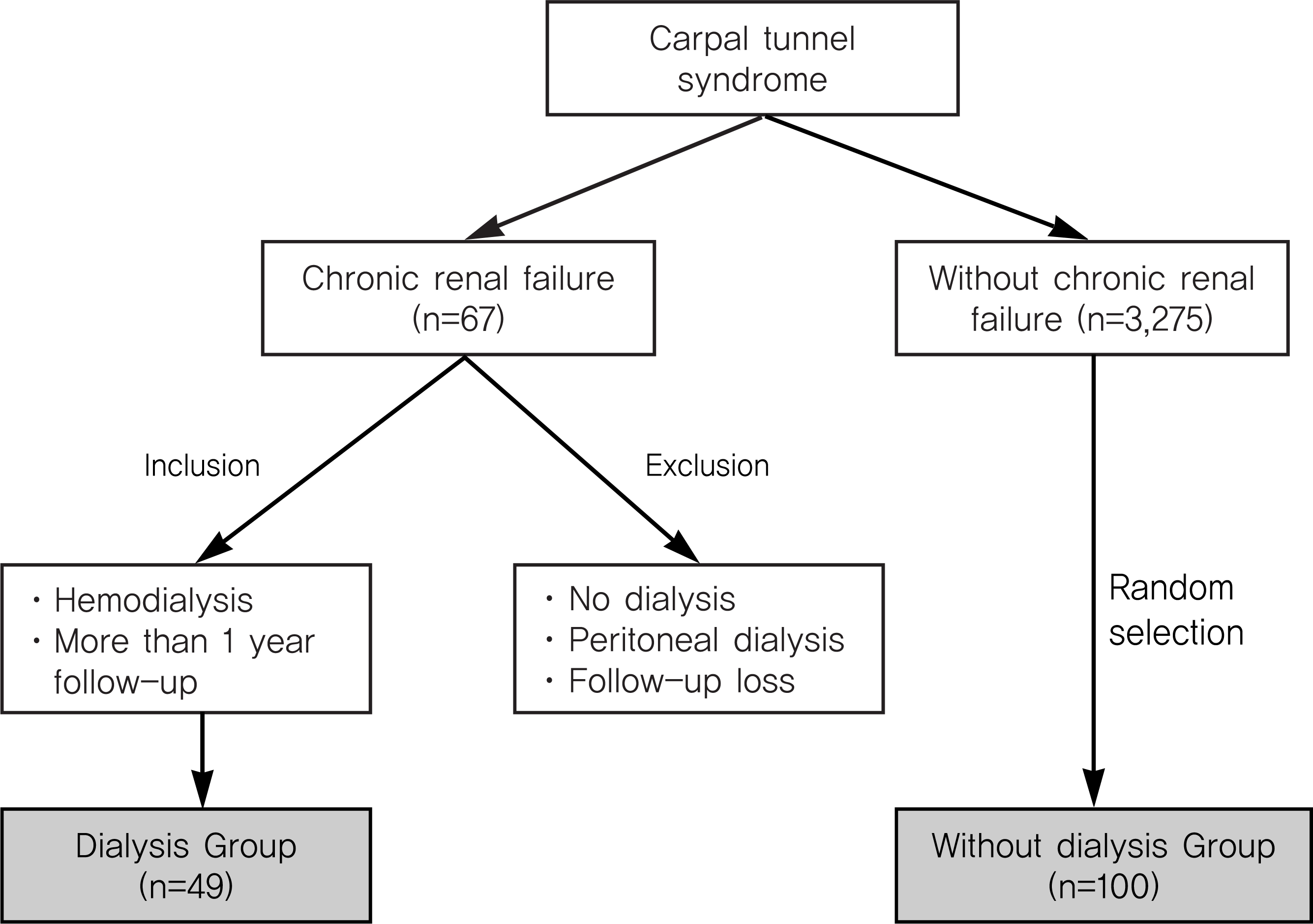Abstract
Purpose:
Carpal tunnel syndrome (CTS) has become increasingly recognized as a complication of long-term hemodialysis. This study evaluated the clinical characteristics and compared the results of carpal tunnel release for CTS patients with or without hemodialysis.
Methods:
We retrospectively reviewed the clinical characteristics and surgical outcomes of 49 chronic hemodialysis patients with 83 CTS hands. Also, 100 patients were selected for the control group. Patient characteristics, accompanying systemic conditions, operative outcomes were compared.
Results:
In hemodialysis group, the mean age and hemodialysis duration were 59.5±10.5 years and 4.1±2.5 years, respectively. Of the 83 hands with CTS, 45 (54.2%) had arteriovenous fistulas, while 38 (45.7%) did not (p=0.02). Most (81.6%) of the patients reported symptom improvement after surgical treatment, and the remaining patients (18.4%) reported persistent and recurrent symptoms. Rates of remaining symptoms and reoperations were significantly higher in the CTS patients with hemodialysis group.
Go to : 
References
1. Jain VK, Cestero RV, Baum J. Carpal tunnel syndrome in patients undergoing maintenance hemodialysis. JAMA. 1979; 242:2868–9.

2. Warren DJ, Otieno LS. Carpal tunnel syndrome in patients on intermittent haemodialysis. Postgrad Med J. 1975; 51:450–2.

3. Lin HH, Chen HT, Chen YC, Fang JT, Huang CC. Carpal tunnel syndrome in long-term hemodialysis patients. Acta Neurol. 2001; 15:111–4.
4. Bardin T, Zingraff J, Kuntz D, Drueke T. Dialysis-related amyloidosis. Nephrol Dial Transplant. 1986; 1:151–4.
5. Brown EA, Arnold IR, Gower PE. Dialysis arthropathy: complication of long term treatment with haemodialysis. Br Med J (Clin Res Ed). 1986; 292:163–6.

6. Hirasawa Y, Ogura T. Carpal tunnel syndrome in patients on long-term haemodialysis. Scand J Plast Reconstr Surg Hand Surg. 2000; 34:373–81.
7. Kang HJ, Koh IH, Lee WY, Choi YR, Hahn SB. Does carpal tunnel release provide long-term relief in patients with hemodialysis-associated carpal tunnel syndrome? Clin Orthop Relat Res. 2012; 470:2561–5.
8. Nakamoto HA, Ferreira MC, Tustumi F, Milcheski DA. Tuma P Jr. Sensory testing in patients with hemodialysis-associated carpal tunnel syndrome submitted to surgical decompression. Ann Plast Surg. 2014; 72:685–8.
9. Kocyigit I, Unal A, Guney A, et al. Carpal tunnel release surgery and venous hypertension in early hemodialysis patients without amyloid deposits. Scientific World Journal. 2013; 2013:481348.

10. Chung US, Jung WS, Seo WY, Lee KH. Carpal tunnel syndrome in hemodialysis patients. J Korean Soc Surg Hand. 2007; 12:177–80.
11. Delmez JA, Holtmann B, Sicard GA, Goldberg AP, Harter HR. Peripheral nerve entrapment syndromes in chronic hemodialysis patients. Nephron. 1982; 30:118–23.

12. Bussell JA, Abbott JA, Lim RC. A radial steal syndrome with arteriovenous fistula for hemodialysis. Studies in seven patients. Ann Intern Med. 1971; 75:387–94.
13. Kwon HK, Pyun SB, Cho WY, Boo CS. Carpal tunnel syndrome and peripheral polyneuropathy in patients with end stage kidney disease. J Korean Med Sci. 2011; 26:1227–30.

14. Namazi H, Majd Z. Carpal tunnel syndrome in patients who are receiving long-term renal hemodialysis. Arch Orthop Trauma Surg. 2007; 127:725–8.
16. Kim WK, Kwon SH, Lee SH, Sunwoo IN. Asymptomatic electrophysiologic carpal tunnel syndrome in diabetics: entrapment or polyneuropathy. Yonsei Med J. 2000; 41:123–7.

17. Wilson SW, Pollard RE, Lees VC. Management of carpal tunnel syndrome in renal dialysis patients using an extended carpal tunnel release procedure. J Plast Reconstr Aesthet Surg. 2008; 61:1090–4.

18. Gilbert MS, Robinson A, Baez A, Gupta S, Glabman S, Haimov M. Carpal tunnel syndrome in patients who are receiving long-term renal hemodialysis. J Bone Joint Surg Am. 1988; 70:1145–53.

19. Kim SJ, Shin SJ, Kang ES. Endoscopic carpal tunnel release in patients receiving long-term hemodialysis. Clin Orthop Relat Res. 2000; (376):141–8.

20. Shiota E, Tsuchiya K, Yamaoka K, Kawano O. Open carpal tunnel decompression in long-term haemodialysis patients [corrected]. J Hand Surg Br. 2001; 26:529–32.
Go to : 
 | Fig. 1.Patient inclusion and exclusion criteria. 49 chronic renal failure patients who were on hemodialysis and followed-up more than 1 year were included in hemodialysis group. Among 3,275 patients who were without chronic renal failure and diagnosed with carpal tunnel syndrome, 100 was selected randomly and categorized as the “Without dialysis group”. |
Table 1.
Associated systemic conditions
Table 2.
Correlation between fistula side and prevalence of CTS (significant difference, p<0.05)
| Variable | AVF (+) | AVF (-) | Total |
|---|---|---|---|
| CTS (+) | 45 | 35 | 80 |
| CTS (-) | 4 | 14 | 18 |
| Total | 49 | 49 | 98 |
Table 3.
Comparison between groups (significant difference, p<0.05)




 PDF
PDF ePub
ePub Citation
Citation Print
Print


 XML Download
XML Download